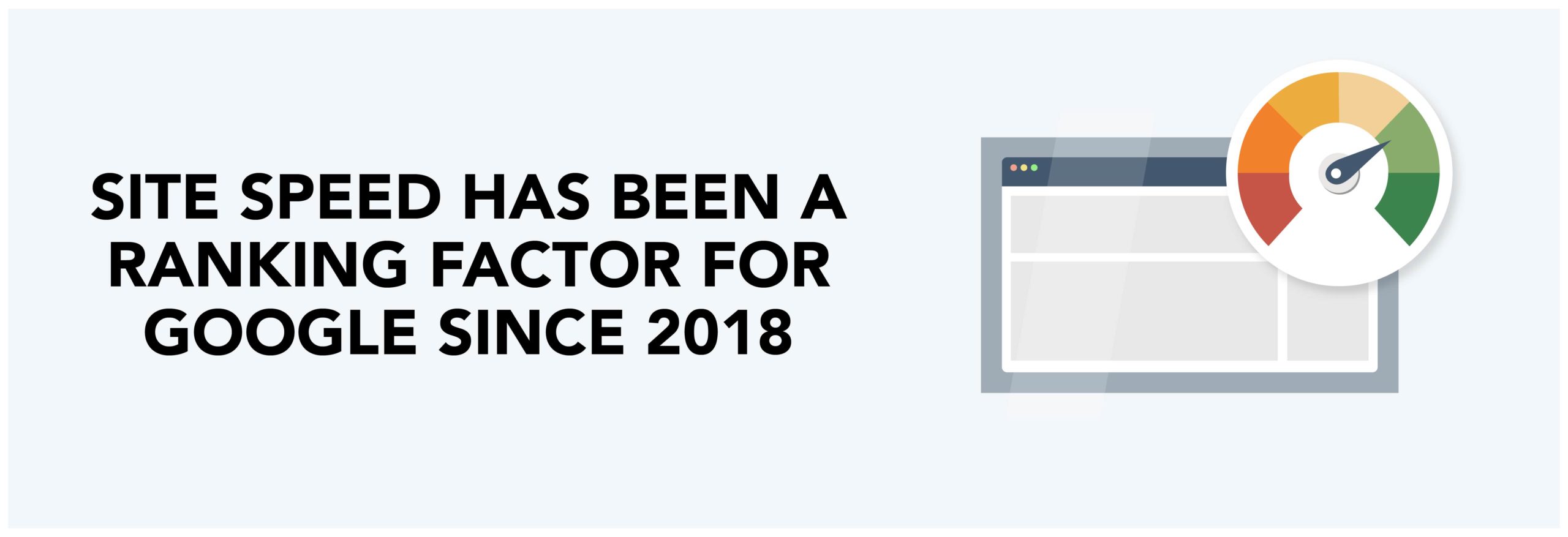Google recently announced a new ranking change will be rolling out in May 2021 called Core Web Vitals, which is, “a set of metrics related to speed, responsiveness and visual stability, to help site owners measure user experience on the web.” With this announcement, our team took a deeper look at the overlap between search rankings, user experience, and accessibility. What so often is true in the world of SEO, when you optimize for one, the other two benefit.
We identified these five areas as primary factors:
- Site Speed
- Images
- Semantic Markup
- Readability
- Video Captions
If your brand evaluates and addresses these five areas, it is bound to increase your search rankings, usability, and accessibility.
1. Site Speed
 Site speed has been a ranking factor for Google since 2018. With the recent Core Web Vitals announcement, Google is tying site speed to a good user experience. If you have a slow website, users will leave before interacting with your page causing a high bounce rate and a poor experience.
Site speed has been a ranking factor for Google since 2018. With the recent Core Web Vitals announcement, Google is tying site speed to a good user experience. If you have a slow website, users will leave before interacting with your page causing a high bounce rate and a poor experience.
How to increase your site speed:
- Audit your website for site speed. Use a tool like Pingdom and WebPage Test to see where your site is slowing down.
- Hire a developer or agency. If you are unfamiliar with the results from an audit, speak with an agency or developer that can help you determine how to improve.
- Resize your images. In many cases, image size is one of the easiest ways to improve load times. When you upload, make sure your images are under 300kb, but the smaller the better.
2. Images
Images help a user understand the product, service or context of your page. By optimizing your images, you increase your chances of being ranked in images, Google Discover, and SERP results. By optimizing your images, you also aid in the screen reader’s ability to explain the image to a user and increase time-on-page.
How to optimize your images:
- Add alt tags using sentence structure. This will help rank in image results and aid users when using screen readers to understand the image.
- Use relevant images with your copy. By surrounding the image with relevant copy and keywords, you’ll help them rank better as well as improving accessibility with screen readers.
- Create the images for the space and reduce file size. Help site speed by sizing the images correctly and not having your site’s backend do the work.
3. Semantic markup
One of the many requirements for WCAG 2.0 is that HTML heading elements (H1, H2, H3, etc.) should provide important document structure to aid with assistive technology. This allows a user using a keyboard or screen reader to quickly understand what are headlines, subheadings and so forth. Not only does this aid with screen readers but the natural hierarchy of reading for a user. By using proper Semantic markup, it allows Google to read your content and possibly provide your page as a featured snippet.
Best practices to follow with site structure:
- Use headings correctly. When it’s a headline use an H tag. When it’s a paragraph use a P tag. This helps screen readers and Google understand your content. Don’t just use the font that looks nice.
- Don’t skip headings. Remember to always have one H1, some H2 and H3s when needed. Don’t skip from H1 to H3. Think about your hierarchy and what content fits within each section.
- Add keywords into your H2 headings. Use your H2’s to answer your users questions. This allows them to quickly find the section they are looking for and help Google rank your content.
4. Readability
When writing your content for your website, keep readability at the forefront of your decisions. Simple, clear language that answers questions effectively will help your content rank. Think quality and depth, not quantity.
Here are a few tips to keep in mind:
- Answer the questions your users are looking for. Users are looking for answers, not just 1 or 2 words. By answering those questions you will engage your users and keep them on your page.
- Don’t stuff your pages with keywords. Write using clear and simple sentences, add your keywords when they make sense.
- Write in easy-to-read paragraphs and bullet points. Make it easy for your users to skim your content. Not only do users prefer this but you are more likely to get picked up for featured snippets.
5. Video Captions
Did you know a US study done by Verizon found that 92% of users view videos without sound? If you are featuring videos on your website an easy win is to add captions. By adding captions it will allow users to take in the video without having to have the sound on, as well as help Google index your video.
Here are best practices for captioning your videos:
- Embed the captions in the video. This allows a user to read the content as they are viewing the video.
- Add a transcript below the video. If the video is featured on a blog, youtube, or social, include the content below the video.
- Check out Google’s latest resources for Video SEO. Make your videos available on the web, create a video sitemap, and include a high-quality thumbnail!
While these are only 5 areas of overlap, there are many more where the user’s experience and accessibility requirements will also help you rank in Google results. While it can be overwhelming, Mad Fish is here to help you walk through the process. Learn more about how we support SEO through our integrated digital services here.

